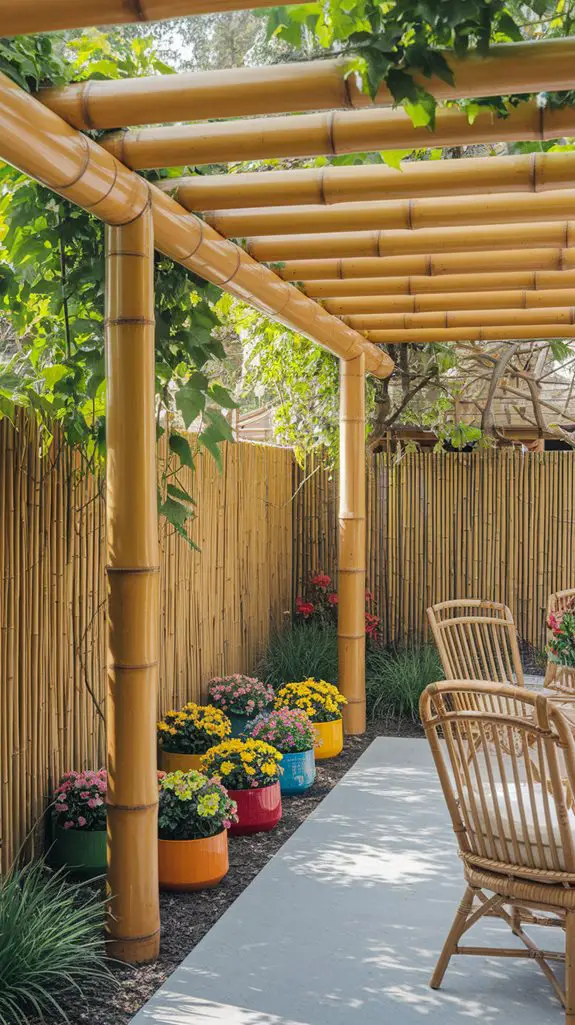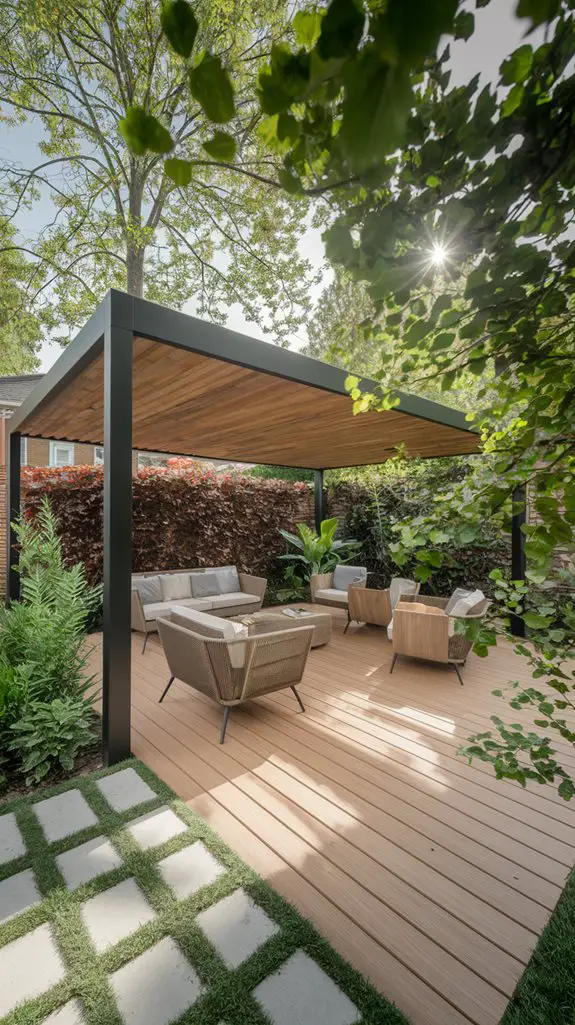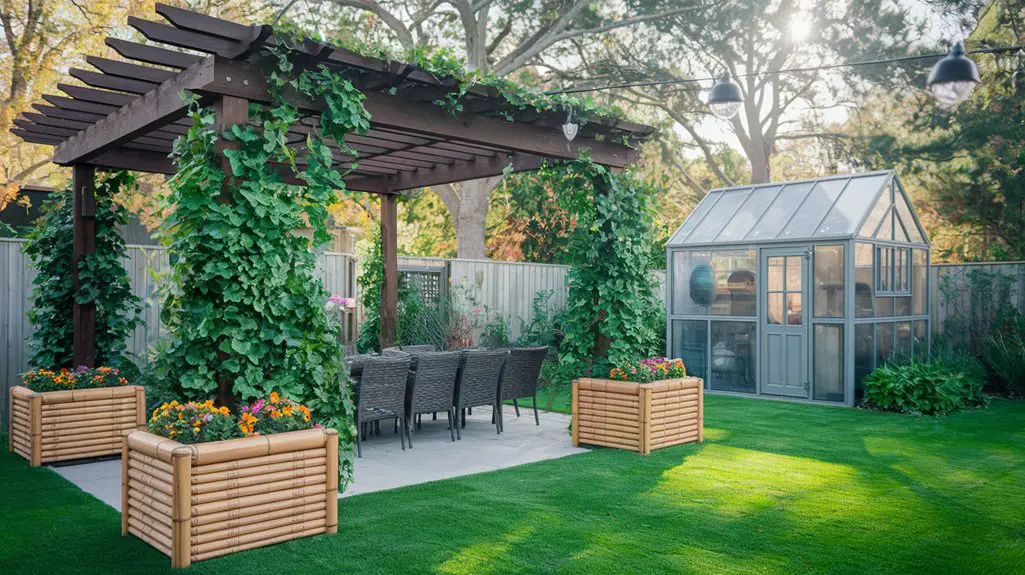Just as you were considering your backyard renovation, sustainable building materials have become more accessible than ever. You’ll find that eco-conscious structures don’t require sacrificing aesthetics or functionality—they actually enhance both while reducing your environmental footprint. From the rich character of reclaimed timber to the surprising tensile strength of bamboo, your choices extend far beyond conventional options. The transformation waiting in your outdoor space might revolutionize how you think about sustainability.
Reclaimed Wood Products for Durable Garden Buildings
When considering materials for your garden shed or greenhouse, reclaimed wood stands out as an exceptional cornerstone for eco-conscious construction.
This repurposed timber brings natural character while diverting valuable resources from landfills.
You’ll find reclaimed barn boards perfect for exterior siding that withstands weather fluctuations better than new lumber, thanks to their decades of natural curing.
For structural elements, salvaged beams offer superior strength and dimensional stability.
Look for certified reclaimed sources that guarantee clean, nail-free materials.
Treatments with natural oils rather than chemical preservatives maintain wood’s breathability while extending its lifespan.
Sustainable Bamboo: The Versatile Construction Alternative

While traditional lumber dominates construction materials, bamboo has emerged as a revolutionary alternative that combines strength with ecological integrity. This rapidly renewable resource grows up to 35 inches daily, reaching harvest maturity in just 3-5 years compared to decades for hardwoods.
You’ll find bamboo exceptionally versatile for pergolas, trellises, and furniture. Its tensile strength rivals steel, yet it’s lightweight and flexible, perfect for curved designs.
When properly treated with borax solutions or heat, bamboo resists insects and moisture, lasting 20+ years outdoors.
Choose laminated bamboo products for decking and structural elements—they’re engineered for durability and dimensional stability. Additionally, using eco-friendly materials can enhance both the aesthetic and environmental impact of your landscape design.
Recycled Composite Materials for Weather-Resistant Structures

Recycled composite materials represent the fusion of sustainability and modern engineering for backyard structures.
These innovative materials combine post-consumer plastics with reclaimed wood fibers to create exceptionally durable boards and panels that withstand moisture, insects, and UV exposure without chemical treatments.
You’ll find these composites ideal for decking, pergolas, and garden boxes in areas with variable weather conditions.
Unlike traditional wood, they won’t splinter, warp, or require regular staining—reducing your maintenance footprint while extending structural lifespan.
Most manufacturers now offer composites with up to 95% recycled content, diverting plastic from landfills while mimicking natural wood aesthetics.
When selecting materials, look for certification from the Forest Stewardship Council or Cradle to Cradle to guarantee you’re choosing truly regenerative options that can be reclaimed at the end of their lifecycle. Additionally, using renewable resources in your landscaping can further enhance your outdoor space’s sustainability.
Earth-Based Building Techniques for Backyard Installations
Earth-based building techniques offer perhaps the most accessible and ecologically sound approaches for creating backyard structures with minimal environmental impact.
These methods—cob, rammed earth, and adobe—harness soil directly from your site, dramatically reducing embodied carbon and transportation emissions.
You’ll find cob (clay, sand, and straw mixture) ideal for curved walls and garden features, while rammed earth creates stunning thermal mass structures that regulate temperature naturally.
Adobe bricks, dried in the sun rather than fired, provide excellent insulation for small sheds and meditation spaces.
Locally-Sourced Stone and Its Environmental Benefits
Stone, nature’s oldest building material, offers exceptional durability while minimizing environmental impact when sourced locally. When you choose stones from within 50 miles of your property, you dramatically reduce transportation emissions while supporting regional economies.
These geological treasures connect your landscape to the surrounding terrain, creating structures that feel rooted in place.
- Feel the satisfying weight of stones that have patiently formed over millennia
- Imagine the generations who’ll enjoy your stone wall or path long after you’re gone
- Experience the peace of building with materials that require no toxic manufacturing
- Celebrate your role in preserving traditional craftsmanship specific to your region
- Marvel at how each unique stone tells Earth’s story through its patterns and textures
- Incorporating rustic backyard garden pathways made of local stone enhances both aesthetics and ecology.
Eco-Certified Metal Options for Long-Lasting Outdoor Frameworks
When selecting frameworks for outdoor structures, eco-certified metals offer exceptional sustainability alongside remarkable durability.
Look for aluminum and steel products with cradle-to-cradle certification, which guarantees materials can be perpetually recycled without quality degradation.
You’ll find that reclaimed steel markedly reduces carbon footprint while providing the structural integrity your pergolas and gazebos demand.
Many manufacturers now offer metals with at least 80% post-consumer content that won’t leach toxins into soil.
Consider weathering steel (COR-TEN) for its self-healing oxide layer that eliminates the need for chemical treatments.
For lighter applications, anodized aluminum frameworks require minimal maintenance and can last decades without replacement—a vital factor in true resource conservation.
Always verify FSC Chain of Custody certification when purchasing to confirm responsible sourcing practices. Additionally, integrating natural materials into your designs can further enhance the eco-friendliness of your structures.
Plant-Based Insulation Solutions for Climate Control
Plant-based insulation materials represent a revolution in eco-conscious climate control for outdoor structures while delivering impressive thermal performance.
You’ll find these biodegradable alternatives outperform conventional options by creating breathable barriers that regulate humidity while minimizing your carbon footprint. Hemp, cotton, and cork insulations regenerate quickly, requiring minimal processing before installation in your garden office or greenhouse.
- Feel the profound connection to Earth as your shelter breathes through living materials
- Experience the quiet sanctuary created by nature’s sound-absorbing fibers
- Marvel at winter warmth retained by the same materials that cool summer air
- Trust in centuries-old indigenous wisdom reimagined for modern sustainability
- Celebrate freedom from toxic off-gassing that conventional insulations release
Conclusion
Like Noah gathering materials for his ark, you’re now equipped to build your backyard sanctuary with purpose. By choosing reclaimed wood, bamboo, recycled composites, earth-based techniques, local stone, eco-certified metals, and plant-based insulation, you’re not just creating structures—you’re participating in Earth’s renewal. Your backyard becomes both a personal Eden and a demonstration of how we can rebuild our relationship with the natural world.




